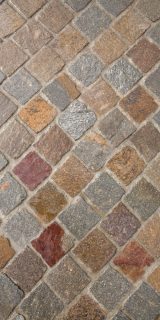Porphyry – Natural Stone Surfacing of Streets
Stone Streets First published in 2000, by the Society of Chief Officers of Transportation in Scotland (SCOTS), Natural Stone Surfacing – Good Practice Guide, was responding to the following regarding their city center streets. “The techniques used in installing stone surfaces which perform well, vary throughout Europe. They are based on semi empirical, traditional, guidance borne […]
Porphyry Pavers: Aspect Ratio, Plan Ratio, Plan Area, Modular Ratio
The shape of the stone unit determines how the stone surface responds under load and the way in which the load will be resisted. Certain shapes of units are better suited to particular forms of construction. While they all can be appropriate for pedestrian use, driveway and city streets have tighter parameters to pay attention […]
Laying Porphyry Paving "Pose de Paves"
A Porphyry installation video of a beautiful cobblestone pathway is educational. This short (2:21) segment showing two posers (layers) and a helper laying overlapping arcs with 4” (8-10cm) porphyry cubes, demonstrates an effortless seeming process of a traditional setting method that dates back centuries. The stone setting skill of these two is highly refined and […]
What is Porphyry?

What is Porphyry? Porphyry has been used as a paving surface as far back as the Roman era. The Romans used it because it had a naturally flat, durable surface and the stone was easy to quarry. Traditional porphyry is a variable thickness stone. It’s a type of granite that has naturally extruded through the […]


